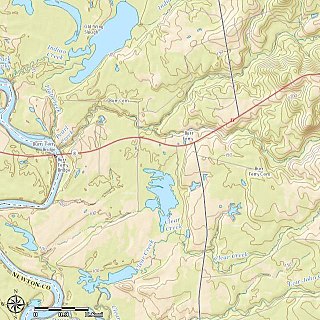
Vernon Parish is a parish located in the U.S. state of Louisiana. As of the 2020 census, the population was 48,750. The parish seat is Leesville. Bordered on the west by the Sabine River, the parish was founded in 1871 during the Reconstruction era.

Sabine Parish is a parish located in the U.S. state of Louisiana. As of the 2020 census, the population was 22,155. The seat of the parish is Many.

Beauregard Parish is a parish located in the U.S. state of Louisiana. As of the 2020 census, the population was 36,549. The parish seat is DeRidder. The parish was formed on January 1, 1913.

Cave-In-Rock is a village in Hardin County, Illinois, United States. Its principal feature and tourist attraction is nearby Cave-In-Rock, on the banks of the Ohio River. In 1816, the earliest known permanent white settlers arrived and started building a town near the cave. The town was originally known as Rock and Cave, Illinois, with a post office under this name. On October 24, 1849, the town was officially renamed Cave-In-Rock. Cave-In-Rock was incorporated as a village in 1901. The population was 318 at the 2010 census.

Vinton is a town in Calcasieu Parish, Louisiana, United States. The population was 3,400 in 2020. It is part of the Lake Charles metropolitan statistical area.

Florien is a village in Sabine Parish, Louisiana, United States. The population was 633 at the 2010 census, down from 692 at the 2000 census. The village is home to the annual Sabine Free State Festival, celebrating the village’s history as part of the Sabine Neutral Strip.

John Andrews Murrell, the "Great Western Land Pirate", was a 19th-century bandit and criminal operating along the Natchez Trace and Mississippi River, in the southern United States. He was also known as John A. Murrell, and his surname was commonly spelled as Murel and Murrel. His exploits were widely known, and he became a legendary figure in fiction, film and television in the 20th century.
Redbone is a term historically used in much of the southern United States to denote a multiracial individual or culture. In Louisiana, it also refers to a specific, geographically and ethnically distinct group.

The Neutral Ground was a disputed area between Spanish Texas and the United States' newly acquired Louisiana Purchase. Local officers of Spain and the United States agreed to leave the Neutral Ground temporarily outside the jurisdiction of either country. The area, now in western Louisiana, had neutral status from 1806 to 1821.

James Ford, born James N. Ford, also known as James N. Ford, Sr., the "N" possibly for Neal, was an American civic leader and business owner in western Kentucky and southern Illinois, from the late 1790s to mid-1830s. Despite his clean public image as a "Pillar of the Community", Ford was secretly a river pirate and the leader of a gang that was later known as the "Ford's Ferry Gang". His men were the river equivalent of highway robbers. They hijacked flatboats and Ford's "own river ferry" for tradable goods from local farms that were coming down the Ohio River.
Sugartown is an unincorporated community and census-designated place in Beauregard Parish, Louisiana, United States, approximately 16 miles (26 km) east of DeRidder. As of the 2010 census it had a population of 54. The geographical center of Sugartown today is posted as the intersection of LA 112 and LA 113. The original community was much larger.

Fort Jesup, also known as Fort Jesup State Historic Site or Fort Jesup or Fort Jesup State Monument, was built in 1822, 22 miles (35 km) west of Natchitoches, Louisiana, to protect the United States border with New Spain and to return order to the Neutral Strip. Originally named Cantonment Jesup, the fort operated from 1822 until 1846. After the abandonment of the fort in 1846, the United States federal government continued to own the abandoned fort site until the privatization of the site in 1869.

Samuel Ross Mason, also spelled Meason, was a Virginia militia captain, on the American western frontier, during the American Revolutionary War. After the war, he became the leader of the Mason Gang, a criminal gang of river pirates and highwaymen on the lower Ohio River and the Mississippi River in the late 18th and early 19th centuries. He was associated with outlaws around Red Banks, Cave-in-Rock, Stack Island, and the Natchez Trace.

Hodges Gardens State Park, previously known as Hodges Gardens, Park and Wilderness Area, is located on 4,700 acres (19 km2) between Florien and Hornbeck, near the Toledo Bend Reservoir of the Sabine River in Sabine Parish, in west central Louisiana. The park is located on U.S. Highway 171 some fifteen miles (24 km) south of Many, the seat of Sabine Parish. The facility offers walking trails, formal gardens, arboretum, the Azalea Overlook, waterfalls, and a visitor center. Originally, privately developed during the 1940s and opened to the public in 1956. The park was formally dedicated on May 1, 1959, and transferred to a non-profit foundation in 1960. In April 2007, it became part of the Louisiana public parks system. It is the largest horticultural park and recreation area in the United States and with the acquisition Hodges Garden became the newest park in Louisiana. As of February 20, 2018, ownership of Hodge's Garden State Park was transferred to the A. J. and Nona Trigg Hodges Foundation and closed. The park remains closed with no plans of reopening.

Robert H. "Three-Fingered" Birch, born Robert Henry Birch, was a 19th-century American adventurer, criminal, soldier, lawman, postmaster, and prospector. He was a member of the infamous "Banditti of the Prairie" in his youth, whose involvement in the torture-murder of Colonel George Davenport in 1845 led to his turning state's evidence against his co-conspirators. Birch was also the discoverer of the Pinos Altos gold mine with Jacob Snively and James W. Hicks. During the American Civil War, he served in the American Southwest with the Confederate forces of the Arizona Rangers and 2nd Texas Cavalry.

Doonbeg is a village in west County Clare, Ireland on the Atlantic coast. The surrounding natural environment has supported its development as a tourist resort. The area was officially classified as part of the West Clare Gaeltacht, an Irish-speaking community, until 1956.
The Sabine Parish School Board is an entity responsible for the operation of public schools in Sabine Parish, Louisiana, United States. It is headquartered in the town of Many.

Cuquío is a town and municipality, in Jalisco in central-western Mexico. The municipality covers an area of 252 square miles (653 km²). It limits to the North with the municipality of Yahualica and the State of Zacatecas; to the South, Zapotlanejo and Acatic; to the East, Yahualica and Tepatitlán; and to the West, Ixtlahuacán del Río. Its name derives from the word Cuixui, which in the Aztec language Náhuatl means kite, and is interpreted as "place of kites," or in Tarascan language, "place of frogs or toads." The foundation of the town is awarded to the Purépechas (Tarascans) who repeatedly ventured through these valleys after the Saltpeter War (1480-1510). As a third version about the origins of the municipality name, it is well known that the tribe of coquias settled in La Cofradía, two kilometers from the current town, whose name is conjectured the denomination comes from. Cuquío also depended on the Tonalteca kingdom.
Cerro Colorado is a ghost town in southern Pima County, Arizona. The town is located off Arivaca Road, near Arivaca, and is best known for the massacre of mining employees by Mexican outlaws and buried treasure.

Burr Ferry is an unincorporated community at the junction of LA 8 and LA 111 south, in Vernon Parish, Louisiana, United States. The community is two miles from the site of the old Burr's Ferry on the Sabine River, at the Texas line. The Sabine River, at this location, is the site of two listings on the National Register of Historic Places; Burr's Ferry Bridge, and Burr's Ferry Earthworks.
Sandel, Luther. (1981) "Sabine Free State "Neutral Strip" First Annual Festival book.















